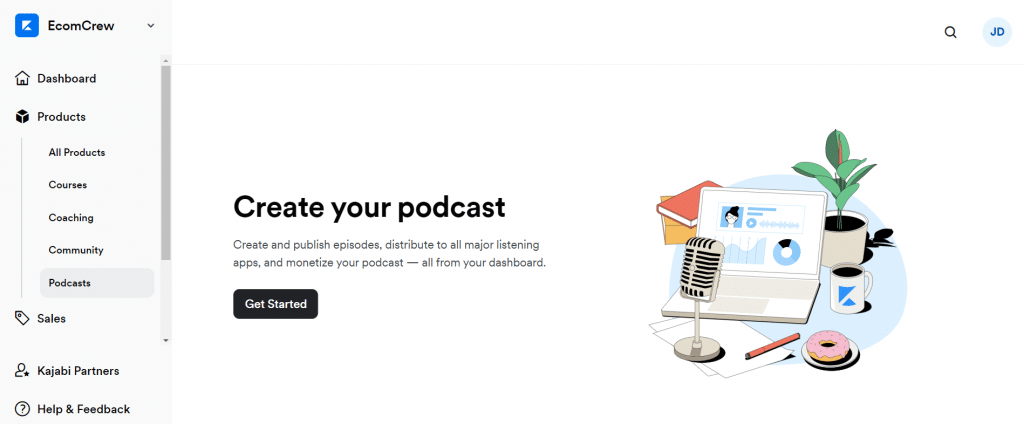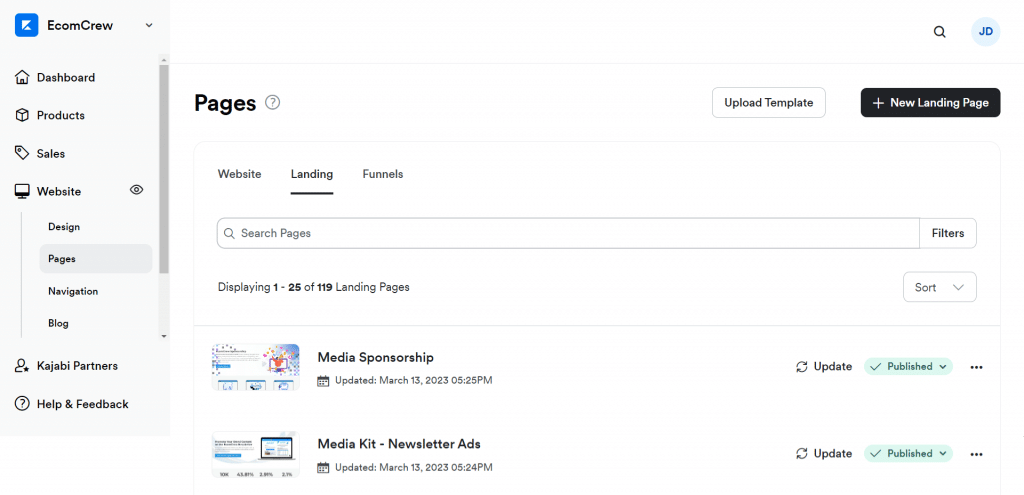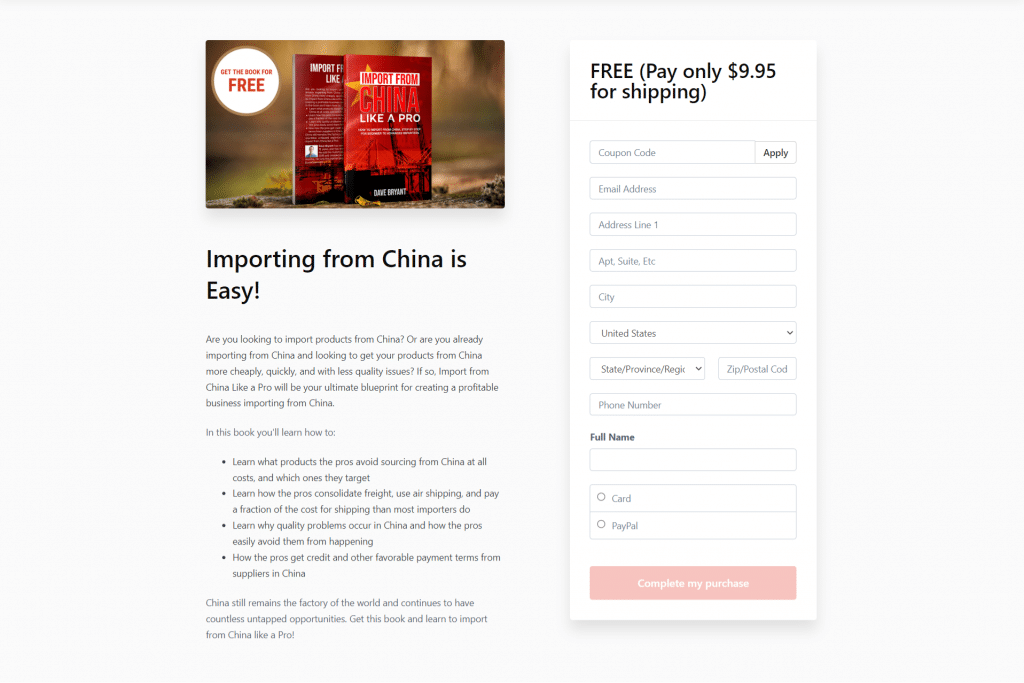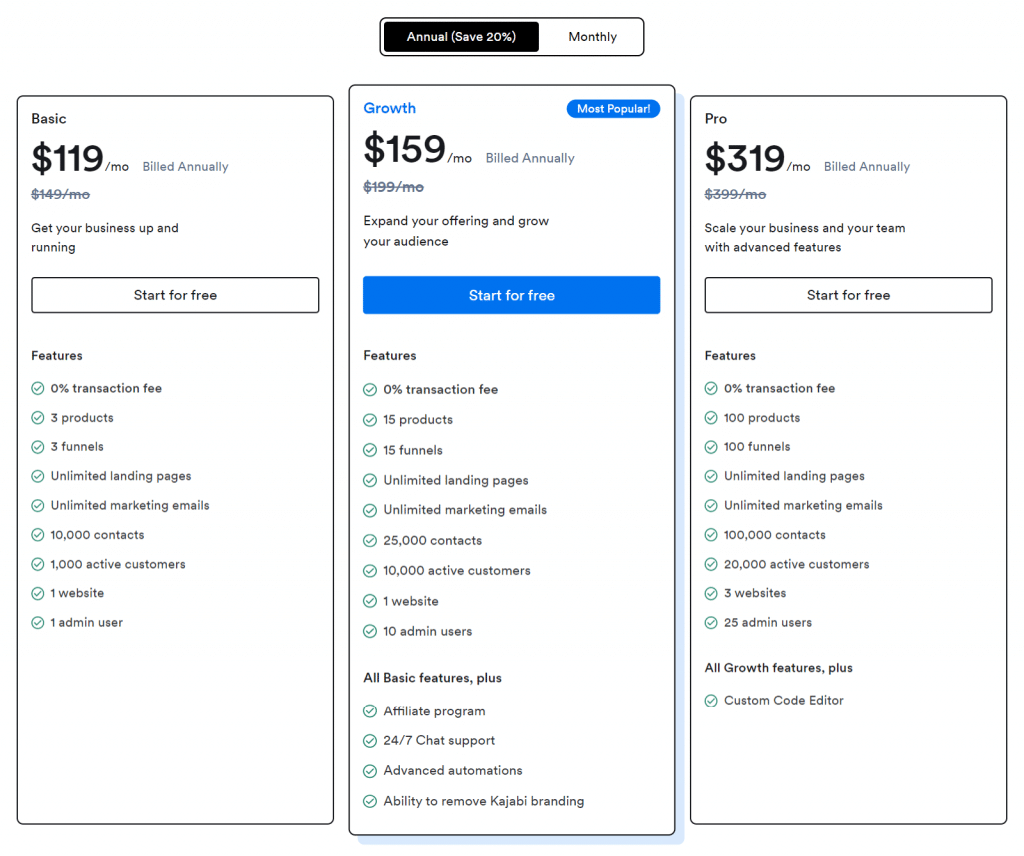Kajabi Review and Pricing–Is It Still Worth It in 2024?
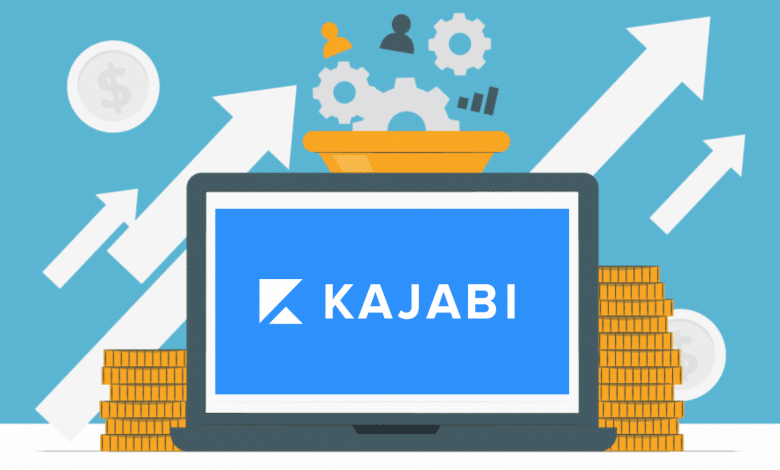
Disclaimer: This article contains our affiliate link to Kajabi. We get a small commission when you sign up through our link, at no extra cost to you. Read our full Affiliate Disclosure here.
Running a digital content business can be overwhelming.
You need a tool that lets you manage your content, nurture your audience, and grow your brand all in one place.
For us here at EcomCrew, that tool is Kajabi, and in this article, we’ll break down Kajabi’s features, pricing structure, and pros and cons to help you decide if it’s the right fit for your business.
What Is Kajabi?
Kajabi is a platform that allows creators to sell digital content online. It caters to those who sell online courses, subscription memberships, and digital downloadables.
It also comes with native content and marketing tools. With Kajabi, you can create email marketing campaigns, landing pages, sales funnels, and also integrate payment solutions into your website.
Overall, it’s a solid choice if you want to focus on creating and selling digital products and you don’t want to worry too much (if at all) about technical stuff like web development, hosting, and payment processing.

Free for 14 days.
What Features Does Kajabi Offer?
Kajabi offers a robust feature set, which is its biggest selling point, that lets you create, market, and sell your digital content all in one place. Below are some of the key features that we constantly use for running our content business:
Platform for Online Courses
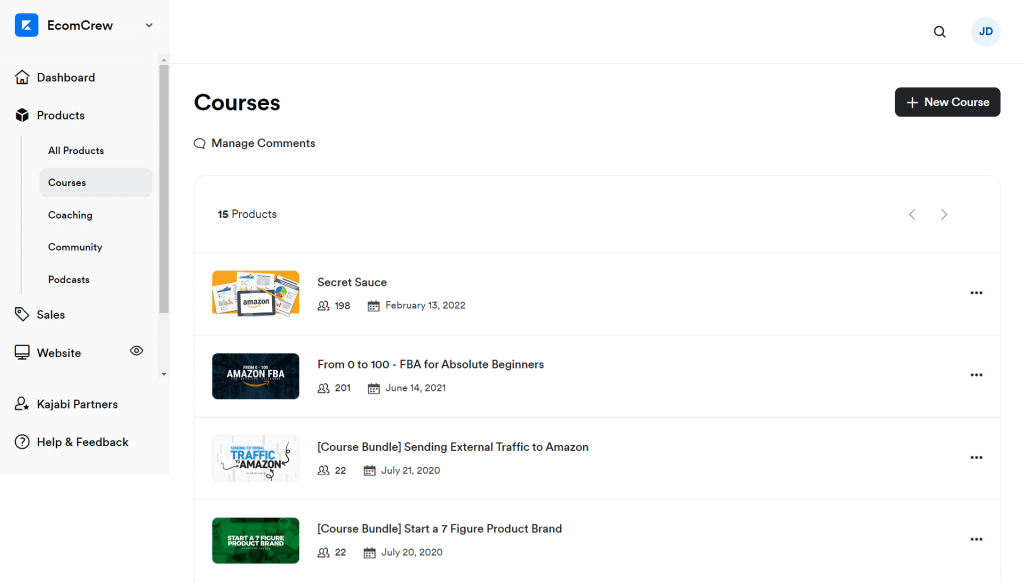
Kajabi offers a lot of course creation tools that make it easy for you to make entire classes from scratch. It supports video format, written materials, and other forms of digital content.
Website Management
As an all-in-one tool, Kajabi allows you to create your own website and store all of your content and information in one place. It features a simple, although limited in terms of customization options, drag-and-drop website builder that lets you customize your site just as you would with other popular web hosting services without advanced coding skills. The fact that you can create a custom domain is a big plus, too.
We use this in particular for our EcomCrew Premium membership site, which helps us manage our paid site and offer our exclusive content to our premium members.
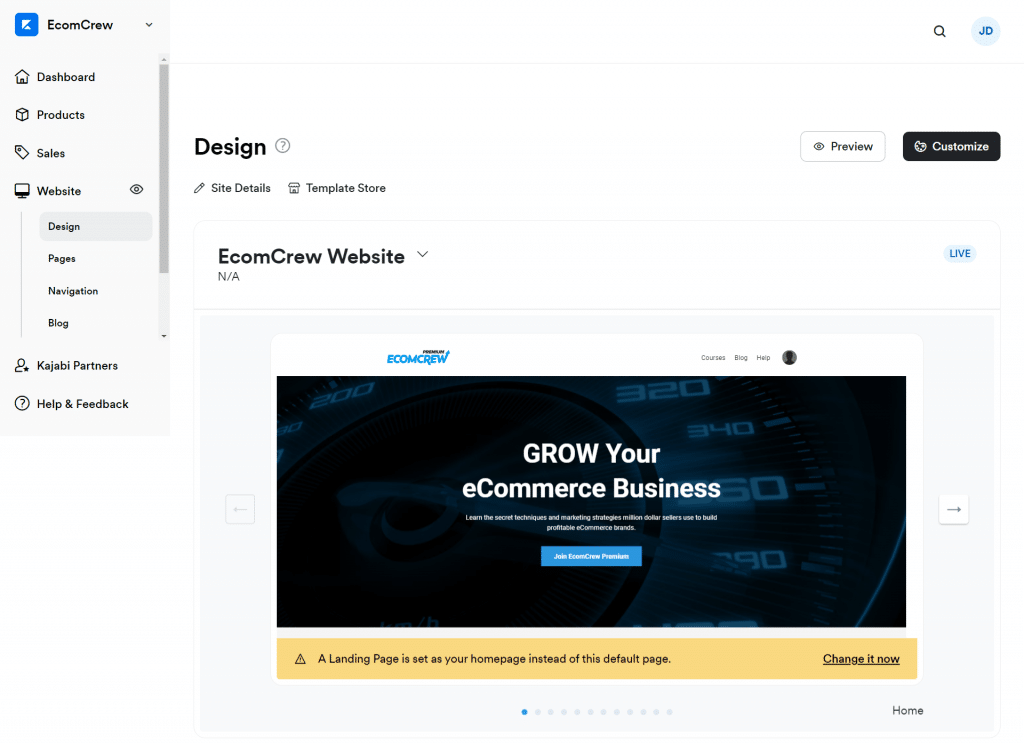
Podcast Creator
Another neat feature is Kajabi’s podcast creator under the products tab, which lets you start and grow a podcast all within the tool, and later on integrate your podcast content into your Kajabi website.
Email Marketing
A feature that we at EcomCrew use day-to-day, Kajabi’s email marketing tool lets you craft and send out newsletters, promo emails, and set up automated marketing campaigns to your subscribers. It also has native data and analytics tools to help you optimize your campaigns over time.
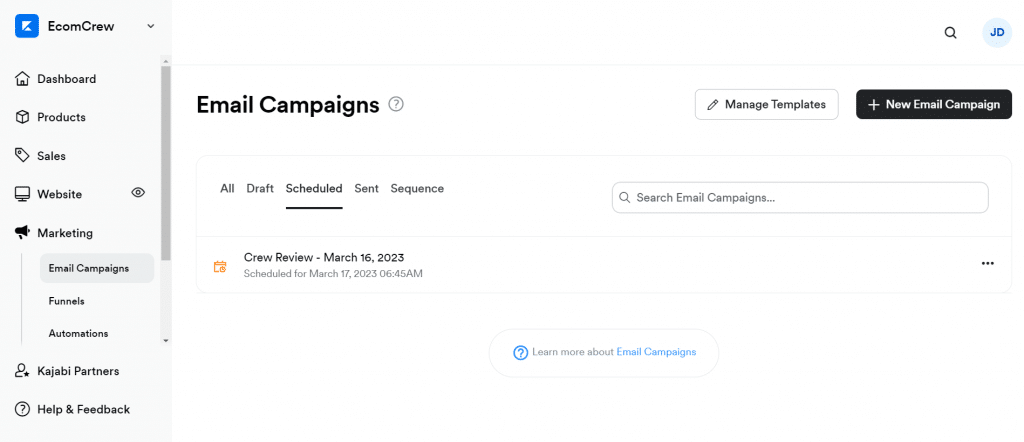
Lead Magnet and Landing Pages
Kajabi's landing page builder lets you create powerful pages and lead magnets to capture visitors’ information and drive them to take action. You can use your free material such as ebooks and webinar replays to capture leads.
Sales Channels and Payment Platforms
Kajabi offers a sales funnel builder that lets you craft a step-by-step process for your customers. This is coupled with its payment processing feature that lets you integrate Paypal and Stripe to your pages.
Within the same subsection on Kajabi, you will also find a Coupons tab that lets you craft personalized or general coupons for your digital products, which customers can use to get deals when checking out.
Can You Sell Physical Products on Kajabi?
The quick answer is no—at least not directly.
Kajabi is primarily designed for creators who sell digital products online, not ecommerce sellers who sell and ship physical merchandise to online shoppers. This means that it does not have some of the functionalities that you would look for in an ecommerce tool.
For instance, Kajabi does not offer shipping or fulfillment services nor any integration to any similar service. It also does not have a quantity selector and “Add to Cart” button. Also, it requires customers to create user accounts when shopping, which does not exactly make for a seamless shopping experience.
That being said, there are options to be able to leverage your Kajabi audience and sell physical products. One method is by embedding Shopify’s Buy Button into your Kajabi pages or by integrating your preferred third-party distribution service using Zapier. By doing this, you can embed a widget on your Kajabi page and sell your products through the Shopify platform (So buyers are basically buying through Shopify, not Kajabi).
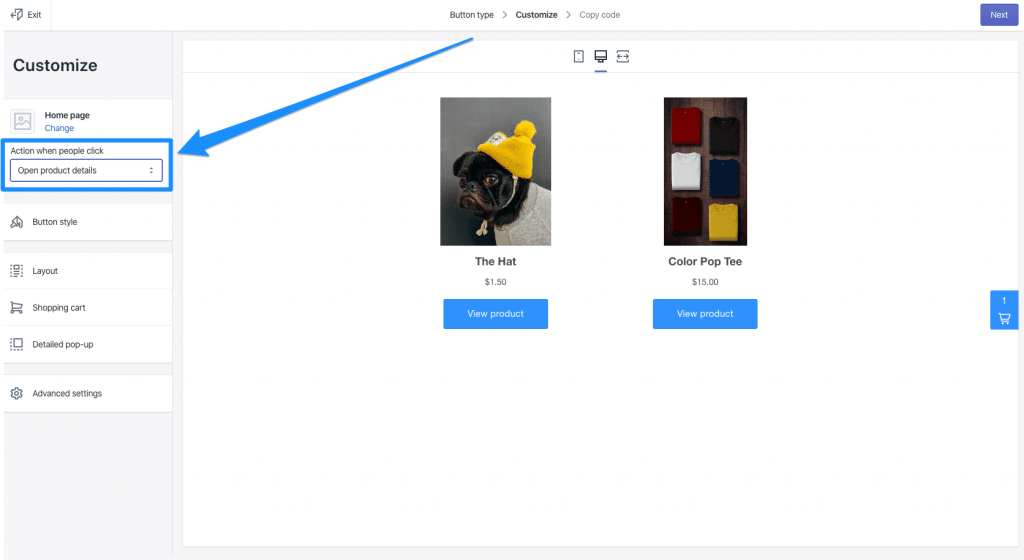
Another way—and one that applies if you’re selling print-on-demand products in particular—is by making use of Kajabi’s collaboration with Sprint. Sprint is a platform that handles printing, shipping, and customer service for physical merchandise. Like with Shopify, Spring can be integrated with Kajabi using a code snippet to embed a widget on a Kajabi page.
What Are the Pros and Cons of Kajabi?
While Kajabi offers a lot of perks, there are also some drawbacks that we found over several years of using the tool.
Kajabi Pros
- All-in-one solution—you likely won't need any third-party service to get your digital content business up and running
- Custom domain naming can mmake your Kajabi-hosted course appear as part of your website
- Reliable sales pipeline builder
- Coaching platform for interactive sessions
- Marketing automations
- Built-in community lets you engage with students and subscribers and even upsell your other content
Kajabi Cons
- Significantly pricier than most alternative tools and has no free option
- Limited integration with third-party tools
- Limited website design and customization features
- No native feature for generating completion certificates for students taking your courses
Kajabi’s biggest selling point is its robust feature set, from website customization, to its marketing tools, to its coaching platform and native community feature. That being said, it comes at a pretty hefty price, which could put off content creators who are only just starting out and are not ready to spend a lot for Kajabi just yet.
How Much Does Kajabi Cost?
Kajabi offers three pricing plans: Basic, Growth, and Pro:
Basic Plan
The cheapest plan costs $149 per month or $119 per month if you pay annually. This plan will give you access to the essentials, including the website builder, course creator, and marketing suite. However, you will be limited to three products and three pipelines only, so you’ll need to look at the pricier options if you want to scale further.
Growth Plan
The second option, which is also the most popular, is the Growth Plan for $199 per month or $159/month annually. This is a big step up from the basic plan because it lets you offer unlimited products, pipelines, and includes marketing automations.
Pro Plan
For large-scale content businesses, the Pro Plan is a solid choice for $399 per month or $319 per month if you pay annually. This plan includes the whole enchilada, with the addition of advanced automations, an affiliate program management, and a code editor.
What Are the Best Alternatives to Kajabi?
Since Kajabi is an all-in-one suite, there aren’t many alternatives that offer a similarly comprehensive toolkit at a more competitive price. However, there are options that are very good at one particular thing, and they could make sense depending on what your focus and objectives are. While the list below is by no means exhaustive, it should give you an idea of the other tools out there:
Systeme.io
Systeme.io is the new kid on the block that’s similar to Kajabi in many ways, being an all-in-one platform for course creation and selling digital products. Its features include online course creation and management, a sales funnel builder, email marketing tools, affiliate program management, and payment service integrations.
Thinkific
Thinkific is a multimedia course content tool that banks on simplicity with its drag-and-drop interface, making it a popular choice for startups or small-scale content creators. Its biggest limitation is that there is no email marketing feature and it has relatively dated design templates and limited customization capabilities.
Podia
Podia is a competing all-in-one platform that’s widely considered a cheap alternative to Kajabi. Its pricing starts at $39/month, making it lighter on the wallet for beginners.
It also offers a free plan with limited capabilities and supports unlimited courses and coachings. However, it does not have course blueprints nor the ability to craft sales funnels.
Skillshare
Skillshare is one of the most popular sites in the online learning industry, in large part because of its marketplace system where creators and entrepreneurs can promote and sell their courses.
If your focus is solely content creative and creativity, there are few platforms that can match Skillshare’s offering.
Teachable
If what you’re looking for is a course creation platform and you don’t plan on offering memberships, Teachable is one of the best choices. It starts at $29/month. Its affinity towards course creation makes it a popular choice for teachers and academic institutions.
Kartra
Karta is a Kajabi alternative for those who lean heavily towards marketing. Its marketing-centric feature set is available starting at $99/year. A good number of ecommerce sellers opt for Kartra because it's easier to sell both digital and physical products on this platform. It even has a built-in sales tax calculator.
Is Kajabi Worth It?
Verdict: Yes, Kajabi is worth it in 2024. At the end of the day, if you’re looking for a nice all-around tool that lets you manage an entire spectrum of digital content, including the technicalities of running a website and managing payments, it’s almost a no-brainer. That said, its extensive feature set means a steep price that may not make it ideal if you’re only just trying to get the ball rolling for your course or subscription business.
Be sure to identify your current focus as an online entrepreneur as well as your business needs and goals before jumping into its paid plans.
Are you using Kajabi or some other tool? We’d love to hear your thoughts in the comments below.
